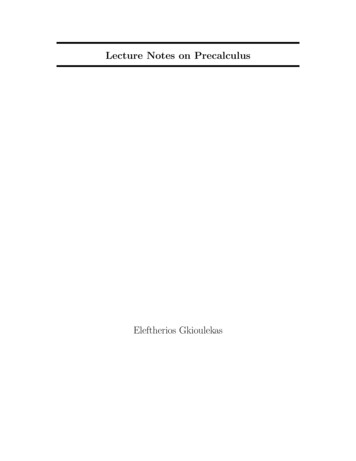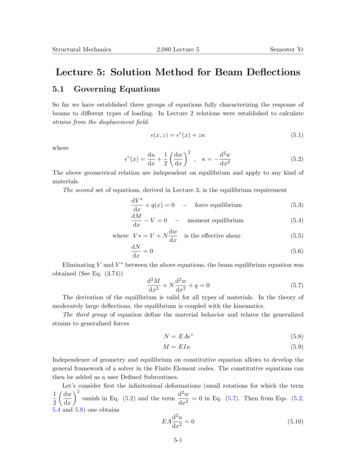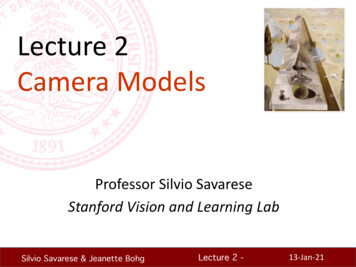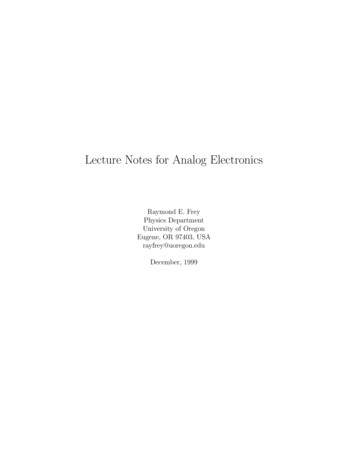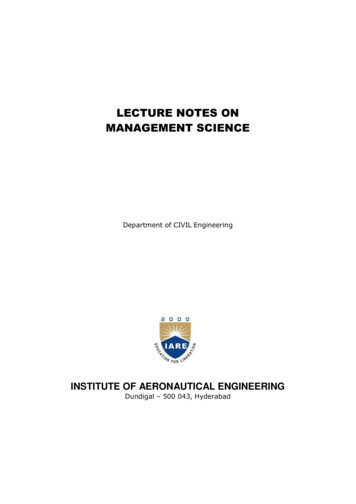
Transcription
LECTURE NOTES ONMANAGEMENT SCIENCEDepartment of CIVIL EngineeringINSTITUTE OF AERONAUTICAL ENGINEERINGDundigal – 500 043, Hyderabad
CONTENTSUnit –I:Introduction to Management:Concepts of Management and organization- nature, importance and Functions of Management, Systems Approach to Management- Taylor's Scientific Management Theory- Fayal's Principles of Management- Maslow's theory of Hierarchy of Human NeedsDouglas McGregor's Theory X and Theory Y - Hertzberg Two Factor Theory of Motivation - Leadership Styles, Socialresponsibilities of Management.UNIT -II:Designing Organization:Designing Organizational Structures: Basic concepts related to Organization - Departmentation and Decentralization, Types andEvaluation of mechanistic and organic structures of organization and suitability. line ,line and staff organization, function,committee, matrix, virtual, cellular, team organization. boundary less organization, inverted pyramid structure , lean and flatorganizationUNIT - III:Operations and Marketing Management:Principles and Types of Plant Layout-Methods of Production(Job, batch and Mass Production), Work Study - Basic procedureinvolved in Method Study and Work Measurement - Business Process Reengineering(BPR) - Statistical Quality Control: controlcharts for Variables and Attributes (simple Problems) and Acceptance Sampling, TQM, Six Sigma, Deming's contribution to qu ality,Objectives of Inventory control, EOQ, ABC Analysis, Purchase Procedure, Stores Management and Store Records - JIT System,Supply Chain Management, Functions of Marketing, Marketing Mix, and Marketing Strategies based on Prodcut Life Cycle,Channels of distribution.UNIT –IV:A)MATERIAL MANAGEMENT:Objective, Need For Inventory Control, EOQ, ABC Analysis, purchase procedure , store management and store records supply chain managementB)MARKETING:Function of marketing, marketing mix, marketing strategies based on product life cycle, channels of distributionUNIT - V:Human Resources Management(HRM):Concepts of HRM, HRD and Personnel Management and Industrial Relations (PMIR), HRM vs. PMIR, Basic functions of HRManager: Manpower planning, Recruitment, Selection, Training and Development, Placement, Wage and Salary Administration,Promotion, Transfer, Separation, Performance Appraisal, Grievance Handling and Welfare Administration, Job Evaluation and Mer itRating - Capability Maturity Model (CMM) Levels - Performance Management System.UNIT - VI:Project Management (PERT/ CPM):Network Analysis, Programme Evaluation and Review Technique (PERT), Critical Path Method (CPM), Identifying critical path,Probability of Completing the project within given time, Project Cost Analysis, Project Crashing (simple problems).UNIT - VII:Strategic Management:Mission, Goals, Objectives, Policy, Strategy, Programmer, Elements of Corporate Planning Process, Environmental Scanning,Value Chain Analysis, SWOT Analysis, Steps in Strategy Formulation and Implementation, Generic Strategy alternatives.
UNIT-1INTRODUCTION TO MANAGEMENTIntroduction to Management: When human being started group activities for theattainment of same common objectives whenever a group is formed and a groupactivity is organized to achieve certain common objectives management is needed todirect, co-ordinate and integrate the individual activities of a group and secure teamswork to accomplish organizational objectives. The objectives of all business areattained by utilizing the scare resources like men, materials, machines, money etc.In process of management, a manage uses human skills, materialresources and scientific methods to perform all the activities leading to theachievement of goods.Definition: “Management is knowing exactly what you want men to do and thenseeing that they do it the best and cheapest ways”.F.W.Taylor “Management is defined as the creation and maintenance of an internalenvironment in an enterprise where individuals working together in groups, canperform efficiently and effectively towards the attainment of group goals”.Koontz and O’DonellNature of Management: The study and application of management techniquesin managing the affairs of the organization have changed its nature over theperiod of time.Multidisciplinary: Management is basically multidisciplinary. This implies that,although management has been developed as a separate discipline, it drawsknowledge and concepts from various disciplines. It draws freely ideas andconcepts from such disciplines as psychology, sociology, nsresearch,etc.Managementintegrates the ideas and concepts taken from these disciplines and presentnewer concepts which can be put into practice for managing the organization.Dynamic nature of principle: Based on integration and supported by practicalevidences, management has formed certain principles. However, these
principles are flexible in nature and change with the changes in the environmentin which an organization exists.Relative, not absolute principles: Management principle are relative, notabsolute, and they should be applied according to the need of the organization.Each organization may be different from others. The difference may existbecause of time, place, socio-cultural factors, etc.Management Science or Art: There is a controversy whether management isscience or art. However, management is both a science and art.Management as profession: Management has been regarded as profession bymany while many have suggested that it has not achieved the status of aprofession.Characteristics of Management:Setting goals for organizations: Goals differ from organization to organization inbusiness, the basic economic goal is to earn maximum profit, while in serviceorganization like hospital and educational institution for the basic goal is toprovide better service and better education.Awareness of opportunities and resources: Management have awareness ofopportunities and resources like men, materials, money which assembles andintegrates by management.Management is transformation process: Management is a transformation processconsisting of planning, organizing, staffing, directing and controlling.Management is universal: The principles and techniques of management areuniversally applicable to all group activities performed at any level oforganization.System of authority: System of authority means a hierarchy of command andcontrol. Managers at different levels possess varying degrees of authority.Co – Ordination: Various human beings organized in formal groups areendeavoring to achieve the common organizational objectives, so variousdepartments in the organization must work in harmony with one another.Management is Dynamic: The ever changing social environment directly and
indirectly effect the group activity thus changing environments provide a
challenge to management. Efficient management can not remain static it mustadopt it self to changing conditions.Management is decision making: The managers are decision makers themarketing managers decides about how to market, when to market, where tomarket how to collect funds for organization.Management is a profession: Management is not only a science but also an art.Art means managers has to handle the person and things tactfully. Sciencemeans achieving objectives through procedures
Importance of Management: “No ideology, no ism, or political theory can wingreater output with less efforts from a given complex of human and materialsresource only sound management And it is on such greater output that a higherstandard of life, more leisure, more amenities for all must necessarily be found”.Effective utilization of resources: Management tries to make effective utilizationof various resources. The resources are scarce in nature and to meet thedemand of the society, their contribution should be maximum for the generalinterests of the society. Management not only decides in which particularalternative a particular resource be used but also takes actions to utilize it in thatparticular alternative in the best way.Development of resources: Management develops various resources. This is truewith human as well as non-human factors. Most of the researches for resourcedevelopment are carried on in an organization way and management is involvedin those activities.To incorporate innovations: Today changes are occurring at a very fast rate inboth technology and social process and structure these changes need to beincorporated to keep the organizations alive and efficient. Therefore, they requirehigh degree of specialization, high level of competence, and complex technology.All these require efficient management so that organizations work in the mostefficient way.Integrating various interest groups: In the organized efforts, there are variousinterest groups and they put pressure over other groups for maximum share inthe combined output. For example, in the case of business organization, thereare various pressure groups such as shareholders, employees, government etc.These interest groups have pressure on an organization.Stability in the society: Management provides stability in the society by changingand modifying the resources in accordance with the changing environment of thesociety. In the modern age, more emphasis is on new inventions for thebetterment of human beings. These inventions make old systems and factorsmostly obsolete and inefficient. Management provides integration between
4
traditions and new inventions and safeguards, society from the unfavorableimpact of these inventions so that continuity in social process is maintained.Levels of Management:1. Top Management2. Upper Middle management3. Middle Management4. Lower Management5. Operating Force or Rank and file workmenTop Management includes:a) Board of directorsb) Managing directorsc) Chief executivesd) General Managere) Ownersf) Shareholders Functions:a) Setting basic goals and objectivesb) Expanding or contracting activitiesc) Establishing policiesd) Monitoring performancee) Designing/Redesigning organization systemf) Shouldering financial responsibilities etc.upper Middle Management includes:a) Sales executivesb) Production executivesc) Finance executivesd) Accounts executivese) R&Dexecutives Functions:a) establishment of the organization
b) Selection of staff for lower levels of management5
c) Installing different departmentsd) Designing operating policies and routinese) Assigning duties to their subordinatesMiddle Management includes:a) Superintendentb) Branch Managersc) Generalforcemeatetc. Functions:a) To cooperate to run organization smoothlyb) To understand inter locking of department in major policiesc) To achieve coordination between different parts of the organizationd) To conduct training for employee developmente) To build an efficient company team spiritLower Management includes:a) Foremenb) Supervisors or charge-handsc) Office Superintendentd) Inspectors etc.Functions:a) Direct supervision of workers and their workb) Developing and improving work methods operationsc) Inspection functiond) Imparting instruction to workerse) To give finishing touch to the plans and policies of top managementf) To act as link between top management and operating forceg) To communicate the feelings of workers to the top management.Operating force includes:a) Workersb) Rank and file workmanc) Skilled and Semi-skilled workersd) Unskilled workers
6
Function:a) To do work on machines or manually, using tools etc.b) To work independently (incase of skilled workers) or under theguidance of supervisor.7
Functions of Management:Planning: Involves selecting the objectives and actions to achieves themplanning stage involves decision making and choosing future courses of actionfrom the various alternativesOrganizing: Role of each person in any organization is fixed. The concept of roleis who will be doing what should be known, to achieve organizational targetsefficiently. It is intended that all the tasks necessary to achieve targets areassigned to people who can do the best.Staffing: Staffing function includes keeping the various organizational positionfixed. This activity is done by identifying work force requirements, keeping therecords of the performance of people working with the organization. So thatsuitable people can be prompted and at the same time people performing not upto the mark could be send for training. If all the above activities are taking placein nice way in any organization, it will give rise minimum work force turnover.Directing: Directing means influencing people, so that they will contribute to theorganization targets directing involves motivation, leadership styles and propercommunication.Controlling: It is the process of comparing the plans with the results. If there isdeviation attain taken to be bridge the gap between plan and actual results.Coordinating: The essence of management is the achievement of coordinationamong people coordination is a complex process following the principles bywhich organization activity can be accomplished. Coordinative is possible oniy ifall the personnel working in the organization accept the target of theorganization. This target must be clearly defined and ‘sold’ to every oneconcerned.Evolution of Management Theory: Good management intends to achieve anobjective with the least use of man, machine, money and material and at thesame time maximum satisfaction of the participants.Taylor’s Scientific Management: The utility of scientific methods to problems ofmanagement was first introduced by F.W.Taylor
8
Definition: Scientific management may be defined as the “Art of knowing exactlywhat is to be done and the best way of doing it”.Scientific management is the result of applying scientific knowledge andscientific methods to the various aspects of management and the problems thatarise form them.Principles of Scientific Management: Taylor through his principles of scientificmanagement initiated a system in which there would be an effective and fruitfulcoordination and cooperation between the management and the workers.REJECT FAST PRACTICESTAYLOR’S SCIENTIFICMANAGEMENTREPLACE THUMB RULES BYGUIDE LINESSYSTEMIMPROVEMENTCOLLECTION DATADECISIONMAKINGDevelopment of Science for each element of work: Analyze the workscientifically, rather than using thumb rule. It means that an attempt is made tofind out what is to be done by a particular worker, how he is to do it, whatequipment will be necessary to do it. This information is provided to the worker,so as to reduce wastage of tie, material etc. and improve the quality workScientific selection, placement and training of workers: This principle states thatselect the workers best suited to perform the specific task, and then train temwithin the industry in order to attain the objectives of the enterprise workers
should also be trained from time to time to keep them informed of latestdevelopment in the techniques of production.9
Division of Labour: division of work in smaller tasks and separation of thinkingelement of job from doing element of the job, this is the principle of specialization.It is essential for efficiency in all sphere of activities as well as in supervisionworkStandardization of methods, procedures, tools and equipment: Standardizationhelps in reducing time, labour and cost of production. The success of scientificmanagement largely depends upon standardization of system, depends uponstandardization of system, tools, equipments and techniques of productionUse of time and motion study: Taylor’s introduced time and motion study todetermine standard work. Taylor’s undertook studies on fatigue, incurred by theworkers and the time necessary to complete task.Differential wage system: Taylor’s differential piece rate scheme provides anincentive for a worker to achieve high level of optimum output. It distinguishes themore productive workers from less productive workers and motivates them toproduce more.Cooperation between labour and management: Mutual respect and cooperationbetween the workers and management helps in providing proper and effectiveleadership. The labour starts thinking that it is their work and they must put theirheart in the work assigned to him.Principle of Management by Exception: Taylor suggested that only major orsignificant deviations between the actual performance and standard performanceshould be brought to the notice of top management. Top management shouldpay more attention to those areas of work where standards and procedures couldnot be established and where there is a significant variation between standardperformance and actual performance.
10
Administrative Management Theory (Henri Fayol and Others):Henri Fayol is called as father of Modern ManagementHe established the pattern of management and the pyramidal form oforganization. He pointed out that technical ability is more dominating on the lowerlevel of management managerial ability is more important on the higher level ofmanagement.Henri Fayol analyzed the process of management and divided theactivities of an industrial undertaking into six groups1. Technical activities2. Commercial activities3. Financial activities4. Security activities5. Accounting activities6. Managerial activitiesElton Mayo: Elton Mayo generally recognized as father of human relationsapproach Mayo led the team which conducted the study psychological reaction ofworkers in on-the job situations Mayo concluded that work arrangements inaddition to meeting the objective requirements of production must at the sametime satisfy the employees subjective requirement of social satisfaction at hiswork place.Maslow’s Theory:Maslow’s level of hierarchy about human relations and behavioral scienceapproach, his assumptions are based mainly on theory of ‘Human Needs’, hehas defined five level of hierarchy of needs starting from the biological need andthen coming to more intangible ones .1. Physical needs like food, clothes and shelter2. Safety needs freedom from fear of insecurity3. Social needs include a sense of being accepted in the society orenvironment one finds himself in.4. Ego needs include feeling of important and recognition
11
5. Self actualization needs include need or desire for personal fulfillmentof individual potential and activity.SelfActualizationNeedsEgo needsSocial needsSafety needsPhysical needsDouglas McGregor Theory: He divides leadership is two styles labeled theory“X” and theory “Y”. The traditional styles of leadership and controls stated intheory ‘X’ by McGregor, is exercised to managers on the basis of hisassumptions about human beings. These assumptions as laid down or observedby McGregor for theory ‘X’ areTheory “X”:1. An average human being does not like to work and he tries to avoid itas far as possible.2. He avoids accepting responsible and challenging tasks, has noambition but wants security above all.3. Because of this, the employees are to be forced, concerned andthreatened with punishments to make them put their best efforts.
12
These people would not work sincerely and honestly under democraticconditions.However the above assumptions re not based on research finding. Theautocratic style basically presumes that workers are generally lazy, avoid workand shrink responsibilities. It is believed that workers are more interested inmoney and security based on these assumptions the leadership stylesdeveloped, insists on tighter control and supervision.Theory of “Y”:It focuses a totally different set of assumptions about the employees1. Some employees consider work as natural as play or rest.2. These employees are capable of directing and controllingperformance on their own3. They are much committed to the objectives of the organization4. Higher rewards make these employees more committed toorganization.5. Given an opportunity they not only accept responsibility but alsolook for opportunities to out perform others.6. Most of them highly imaginative, creative and display ingenuityin handling organizational issues.
13
System Approach to Management:Modern approaches to understandmanagement is the systems approach. Here the organization is viewed as asystem. Every department is considered as a sub-system, it is also possible thatevery department can be viewed as a system and every section in thedepartment can be viewed as a sub-system, system approach helps to study thebasic feature and functions of the organization its minutest details.The collection of interrelated parts called as sub-system which constitutesone whole unit. System approach facilitates the study of each of these parts indetail to have a close understanding of the whole system.Ex: Every part of the study such as the eyes, brain, and heart can also be viewedas a sub-system, a study of each of the parts of the body in necessary tounderstand the whole body.Herzberg’s Two-factors Theory: Maslow’s theory has been modified byHerzberg and he called in two-factors theory of motivation. According to him thefirst group of needs are such things are such things as company policy andadministration, supervision, working conditions, interpersonal relations, salary,status, job security and personal life.“Herzberg called these factors as ‘dissatisfiers’ and not motivators, by thishe means their presence or existence does not motivate in the sense of yieldingsatisfaction, but their absence would result in dissatisfaction. These are alsoreferred to as ‘hygiene’ factors.In the second group are the ‘satisfiers’ in the sense that they aremotivators, which are related to ‘Job content’. He included the factors ofachievement, recognition, challenge work, advancement and growth in the job.He says that their presence will yield feelings of satisfactory or no satisfaction,but not dissatisfaction.Maintenance factors or dissatisfierMotivational factor or satisfierJob contextJob contentCompany policy and AdministrationAchievement
Quality of supervisionRecognitionRelations with supervisionAdvancement14
Relations with subordinatesPossibility of growthPayResponsibilityLeadership and Leadership Styles:Leader:One who leads a given group or team of people is called leader. If you caninfluence people to perform better in a given organizational setting, thatmeans you are a leader.Leadership is ability to influence people to achieve the given goals in anorganization.A true leader is one who shares success with followers and absorbs allfailures.A manager has to be a mini-leader 9he has to inspire his subordinatesand get work done) and leader to be a mega-leader (otherwise he doesnot understand the ground realities of functioning)Leadership Styles: Leader has to ensure that people under his guidance arecomfortable and their good work is recognized.A good leader has to adopt such a style of working that takes care ofpeople around him. There are also some leader who do not care for people andwho care more for the task completion.Types:Autocratic leadership: Here, leader command the followers and expectscompliance from them for all the instructions given, leaders are more dogmaticand positive. They lead by his ability to withhold or give rewards or punishments.Here, no suggestions from the followers are entertained and almost to-downapproach is seen. They direct others. They do not allow any participation.Democratic leadership: Here leaders consult subordinates and involve them indecision making. They encourage discussion with the group leaders believes intwo-way communication. They listen to followers; try to facilitate the decisionmaking.Free – Rein leadership: Free – Rein leaders exercises little authority and give
maximum freedom to subordinates while making decisions. It is a bottom-up15
approach. Suggestions from the followers are encourage and rewarded. Theygive high degree of independence subordinates in their operations.
Social Responsibility: Social responsibility refers to the process with includesseveral activities from providing safe products and services to giving apportion ofthe company’s profits to welfare ebusinessenterprisehastheresponsibility to provide fair return on capital to the shareholders. The firm mustprovide them regular, accurate, and full information about the working ofenterprise in order to fulfill and encourage their interest in the affairs of thecompany.Responsibility towards consumers: The management has to provide qualityproducts and services to the customers at reasonable prices. It should considercustomer suggestions and also plan it services more effectively throughconsumer satisfaction survey.Responsibility towards employees: Good working conditions motivate workers tocontribute their best it is the responsibility of the management recognize theirunions and respect their right to associate with a union of their choices.Responsibility towards creditors: The business has to repay the loans it hastaken from the financial institutions as per the repayment schedule also it shouldinform the creditors about the developments in the company form time-to-time.Responsibility towards Government: The business firm has to pay its taxes andbe fair in its endeavours. It should also support the government in communitydevelopment projects.Responsibility towards competitors: The business firm should always maintainthe highest ethical standards and maintain cordial relations with each of thecompetitors, which is a critical and sensitive segment.Responsibility towards public: Business units have tremendous responsibilitytowards the general public to support the cause of community development. Mostof the companies maintain public relations departments exclusively to maintaingood relations with the community.
17
UNIT – 2DESIGNING ORGANISATIONAL STRUCTURESOrganization:Organization is form of organizing which is a part of managementprocess Organization defied as collectivity of people for achievingcommonobjectives“Organization means the determination and assignment of dutiesto people, and also the establishment and the maintenance ofauthority relationships among these grouped activities it is thestructural frame work with in which the various efforts are coordinatedand related to each other”.Definitions: “Organization are collectivities of people that have beenestablished for the pursuit of relatively specific objectives on a moreor less continuous basis”.WilliamScott “Organization is the form of every human association for theattainment ofa common purpose”.Mooney and Reilly “Organization involves the grouping of activitiesnecessary to accomplish goals and plans assignment and theseactivities to appropriate departments andpositions to appropriate departments and positions for authoritydelegation and coordination”.Koontzand O’Donnell Organization is used in the following ways with or withoutprefix or suffixg) as entityh) as group of peoplei) as structure
j) as processProcess of Organization:Determination of objectives, strategies, plans and policies: Objectivesshould be clear and precise, because the entire organization is to bebuilt around the objectives of the enterprises.Determination of activities: Determine activities needed to executethese plans and policies and accomplish the objectives. The workload is broken into component activities that are to be performed byall the employees. The activities are so split to determine the jobwhich can be performed by an individual.Separation and grouping of activities: To attain the benefits ofspecialization and division of labour, every company, will separate itsactivities on the basis of primary functions like finance, engineering,purchasing, production, sales and industrial relations. All the similaror directly related activities are grouped together in the form ofdepartments.Delegation of authority: Authority is necessary for the performance ofthe job and therefore authority is delegated to the subordinates forenabling them to carry out their work smoothly and efficiently.Delegation of responsibility: Responsibility may be described as theobligation and accountability for the performance of delegated duties.A superior is always accountable for the acts of his subordinate.Therefore, responsibility always flows from subordinates to superiors.Establish inter-relationships: The grouped activities are placed in theoverall organization structure at appropriate level. It is necessary tointegrate or the these groups of activities through.a) Authority relationship horizontally, vertically and diagonallyb) Organized information or communication system i.e., with the help ofeffective coordination and communication.Providing physical facilities and proper environment: Physical
facilities means provide machinery, tools equipments, infrastructureetc, environment means provide proper lighting, ventilation, heating,cooling arrangement at the work place, reasonable hors of work,safety devices, job security etc2
Principles of Organization:Principle of unity of objectives: An organization structure is effective ifis enables individuals to contribute to entire objectives.Principle of co-ordination: The aim of the objective can be achieved itproper co-ordination exists for efferent activitiesPrinciples of organizational efficiency: An organization is efficient it isstructured to aid the accomplishment of enterprise objective with aminimum of unsought consequences or costs.Span of management principle: In each managerial position, there isa limit to the number of persons an individual can effectively managebut the exact number will depend on the impact of underlyingvariables.Scalar principle: The clearer the line of authority from the ultimatemanagement position in an enterprise to every subordinate position,the clearer will be the responsibility for decision making the moreeffective will be organization communication.Principle of delegation by results e
Introduction to Management: . concepts from such disciplines as psychology, sociology, anthropology, economics, ecology, statistics, operations research, etc. Management integrates the ideas and concepts taken from these disciplines and present newer concepts which ca



